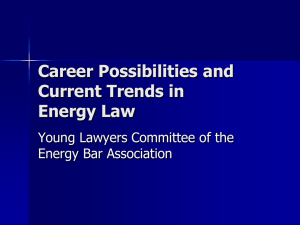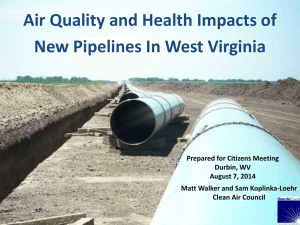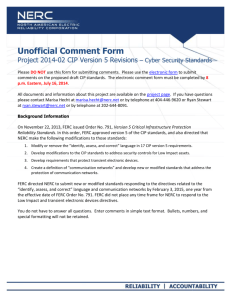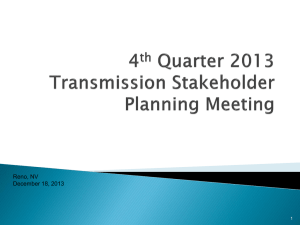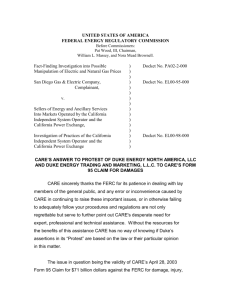ferc jurisdiction over oil pipelines: making growth work
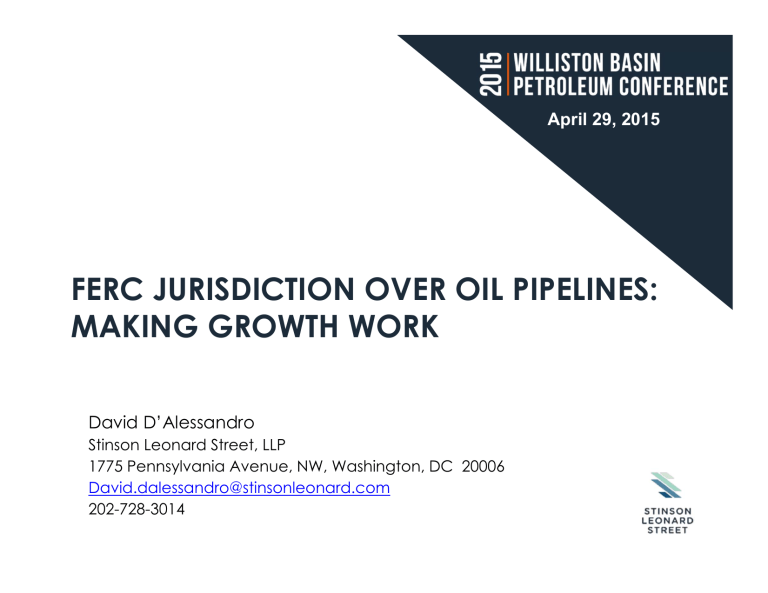
April 29, 2015
FERC JURISDICTION OVER OIL PIPELINES:
MAKING GROWTH WORK
David D’Alessandro
Stinson Leonard Street, LLP
1775 Pennsylvania Avenue, NW, Washington, DC 20006
David.dalessandro@stinsonleonard.com
202-728-3014
OVERVIEW
I.
Hepburn Act of 1906
•
Interstate Commerce Commission regulation of oil pipelines from
1906-1977
•
Jurisdiction over the rates and terms of service
•
Very light-handed regulation by ICC
II.
Department of Energy Organization Act of 1977
•
Transferred oil pipeline jurisdiction to FERC
•
FERC had long history of very active regulation of natural gas pipelines, Federal Power Commission v. Hope Natural Gas Co.,
320 U.S. 591 (1944)
•
FERC struggled with transitional rate making issues from 1977-
1992
•
Energy Policy Act of 1992 grandfathered existing rates and directed FERC to simplify regulation (indexed rate increases)
III.
Increased Production of Crude Oil in U.S. and Canada: 2005-2015
•
Triggered prorationing issues at FERC
•
Triggered long-term contract “ship-or-pay” rates to support financing
1
QUICK OVERVIEW OF FERC RESPONSIBILITIES
2
HYDRO PROJECTS
16 U.S.C.
§§
1-10
A.
Licensing of Hydro projects
B.
Dam Safety Inspection
3
ELECTRIC UTILITIES
FEDERAL POWER ACT 16 U.S.C.
§
824, et seq.
C.
Regulation of Interstate Electric Service (Exemption of Government-owned Utilities & Rural Electric Cooperatives)
D.
Regulation of Electric Mergers - FPA
§
203
E.
Regulation of Interlocking Directorates – FPA
§
305
F.
Regulation of Cogeneration and Small Power
Production Under PURPA
G.
Regulation of Transmission Siting in “National
Interest Corridors”
H.
Regulation of Reliability of Bulk Power System (But
Not: Demand Response
4
NATURAL GAS PIPELINES
NATURAL GAS ACT
15 U.S.C.
§
717, et seq.
I.
Regulation of Interstate Natural Gas Pipeline
Rates and Terms of Service
J.
Regulation of Natural Gas Pipeline Construction
Certificates and Abandonments (preempts New
York State constitution prohibiting the construction of facilities in state forests)
K.
Deregulation of Natural Gas Prices
1980s – unbundling of transportation from sales created a competitive sales market
1993 – Congress deregulated most wholesale sales
5
INTERSTATE OIL PIPELINES
INTERSTATE COMMERCE
ACT 49 U.S.C.
§
1, et seq.
L.
Regulation of Interstate Oil Pipeline Rates and
Terms of Service
M.
Interstate Commerce Act
•
1887 – Enacted to regulate railroads as common carriers by the Interstate Commerce Commission
•
1906 - Amended by the Hepburn Act to add jurisdiction over pipeline transportation of oil and other commodities
(except water and natural or artificial gas)
N.
Department of Energy Organization Act (1977) 42
U.S.C.
§
710, et seq.
•
Jurisdiction over oil pipelines transferred from ICC to FERC
6
RELEVANT ICA STATUTORY PROVISIONS
Regulating the rates and terms of services offered by oil pipelines; 49 U.S.C.
§§
1-20:
•
Section 1(5) - All rates must be just and reasonable
•
Section 6 - Tariffs which set forth the rates and terms of service must be filed with the Commission
No change in the rates and terms of service can be made to any previously filed rate without a 30-day notice(absent special permission)
•
Section 13 - Any person may file a complaint against any rate or practice of a common carrier that the complainant believes is unlawful (unjust and unreasonable or unduly discriminatory)
7
•
Section 15(1) - Gives FERC the authority, either on own initiative or on a complaint, to determine whether an existing rate or practice is unjust and unreasonable and to determine the just and reasonable rate or practice
•
Section 15(7) - Governs proposed changes to existing rates and terms of a tariff. FERC must accept changes that are demonstrated by the Carrier to be just and reasonable
•
If FERC cannot determine from an initial review that a proposed change is just and reasonable, FERC has the authority to institute an investigation/hearing and to suspend the effective date of the proposed change for up to seven (7) months, and allow it to go into effect, subject to refund, pending the outcome of the hearing
•
Section 20 - requires filing of annual and special reports
8
FERC JURISDICTION
•
Transportation of oil in interstate commerce
•
Interstate nature of service determined from character of the commerce from origin to destination. Atlantic Coast Line R.
Co. v. Standard Oil Co. of Kentucky, 275 U.S. 257 (1927).
•
Most common factor is the intent of the shipper at the time of commencement of transportation at point of origin.
Interstate Energy Co, 32 FERC ¶ 61,294 (1985)
•
Shipment of crude oil from an origin in one state to a destination in another state generally will be viewed as one contiguous movement in interstate commerce
•
Disputes about where FERC jurisdiction ends generally arise in cases where the transportation is not contiguous but is interrupted for a period of time
9
FERC JURISDICTION
(CONTINUED)
•
Includes gathering lines that move oil destined for interstate commerce, Texaco Refining and Marketing, Inc. v. SFPP, 80 FERC ¶
61,200 (1997)
•
Includes storage that is integral to interstate transportation, Northville
Dock Pipeline Corp., 14 FERC ¶ 61,111 (1981); Lakehead Pipe Line Co.,
75 FERC ¶ 61,181 (1996)
•
FERC jurisdiction ends when crude oil enters terminal unless terminal is necessary to transfer oil to another interstate movement, TE Products
Pipeline Co., LLC, 131 FERC ¶ 61,277 (2010)
•
Includes pipeline transportation of petroleum products as well as nonenergy liquids; i.e. pure ethanol for feedstock: Williams Olefins
Feedstock Pipelines, L.L.C., 145 FERC ¶ 61,303 (2013 )
•
Rebates are illegal
10
LIMITS ON FERC JURISDICTION
FERC Has No Jurisdiction Over:
•
Break-out and other storage not needed for transportation,
Lakehead Pipe Line Co., 75 FERC ¶ 61,181 (1996)
•
Construction, entry, abandonment of services; e.g. no jurisdiction over closure of propane delivery terminal, Thrifty Propane, Inc. v.
Enterprise TE Products Pipeline LLC, 140 FERC ¶ 61,017 (2012)
•
Pipeline decision to reverse flow of a line, SFPP, 86 FERC ¶ 61,022
(1999)
•
Spur line from a pipeline terminal to a refinery and spur lines connecting internal refining operations to private terminals from which point refined products could begin transportation on a jurisdictional pipeline, Tesoro Refining and Marketing Co., 135
FERC ¶ 61,116 (2011)
11
LIMITS ON FERC JURISDICTION
(CONTINUED)
FERC Has No Jurisdiction Over:
•
Termination of transportation of naphtha while continuing service for propane and other NGLs, Mid America Pipeline Co., 131 FERC
¶ 61,012 (2010), BUT, FERC has jurisdiction to deny proposed cancellation of service of same product (crude), from only certain origin points, while continuing service for the same product from other origins on the same line, Amoco Pipeline Co., 83 FERC
¶ 61,156 (1998)
•
To order pipeline to construct an interconnection to another pipeline, Plantation Pipeline Co. v. Colonial Pipeline Co., 104 FERC
¶ 61,271 (2003); Enbridge Energy, LP, 139 FERC ¶ 61,134 (2012) BUT,
FERC has jurisdiction to enforce agreement by pipeline to continue service, CHS Inc. v. Enterprise TE Products Pipeline Co., 145 FERC ¶
61,056 (2013); SFPP, LP v. FERC 592 F.3d 189 (D.C.Cir 2010); Contract to build Watson facility between SFPP and shippers should have been filed at FERC
12
LIMITS ON FERC JURISDICTION
(CONTINUED)
ConocoPhillips Company v. Enterprise TE Products
Pipeline, 134 FERC ¶ 61,174 (2011)
Involved delivery of propane to a products pipeline at a point in PA not listed as an origin and a redelivery or exchange on the pipeline at Mount
Belview, TX
FERC has no jurisdiction over exchange of petroleum products between a refiner and oil pipelines
No jurisdiction over exchanges between shippers of products delivered to one destination and another destination
13
WAIVER OF FERC JURISDICTION
FERC grants waivers of jurisdiction under Section 6 (to file tariff) and Section 20 (to file Annual Report).
•
Four criteria for waiver:
1.
The pipeline (or its affiliate) owns 100% of throughput moving through the pipeline;
2.
There is no demonstrated 3 rd party interest in using the pipeline;
3.
No such interest is likely to materialize;
4.
There is no opposition to granting waiver
•
Waivers approved:
Bear Paw Energy, LLC, 132 FERC ¶ 61,259 (2010)
MV Purchasing LLC, 133 FERC ¶ 61,251 (2010)
•
Waiver Denied:
Jayhawk Pipeline, LLC, 151 FERC ¶ 61,020 (2015)
(waiver protested)
14
WAIVER EXAMPLES:
•
Pipeline transports only its own crude oil from the Bakken
Shale Formation in North Dakota to its truck take-away facility located in Johnson’s Corner, McKenzie County,
North Dakota. Saddle Butte Pipeline LLC, 136 FERC ¶
61,071 (2011)
•
Pipeline transports only its own unfractionated NGLs from its two new processing facilities in Williams County, North
Dakota to Riverview rail terminal in Richland County,
Montana. ONEOK Rockies Midstream, L.L.C.,
138 FERC ¶ 61,133 (2012)
15
FERC PRORATIONING POLICIES
•
Common carriage obligation requires oil pipelines to ship oil for all shippers that request service
•
Shippers request service by submitting monthly nominations of planned shipments
•
If nominations exceed pipeline capacity, pipeline will pro-rate (reduce) nominations on a nondiscriminatory basis to the level of available capacity
•
There is no one nondiscriminatory method for allocating capacity. Platte Pipe Line Co., 117 FERC ¶
61,296 at P 42 (2006)
16
PRORATIONING METHODOLOGIES:
PRO-RATA BASED
•
Pro-rata method allocates capacity based on the percentage of each shipper’s nomination to total nominations of all shippers
•
Problem: it encourages over nominations
•
Commission approved tariff provisions requiring shippers to “ship-or-pay” for 95% of amount nominated. Enbridge
Energy, LP, 118 FERC ¶ 61,174 (2007)
•
FERC approved caps on nominations based on the capacity of refiners located at mainline destinations or the take away capacity at delivery points located at interconnections. Enbridge Energy, LP, 144 FERC ¶ 61,035
(2013)
17
PRORATIONING METHODOLOGIES:
HISTORICAL – BASED
•
Increased production from Bakken caused nominations to greatly exceed capacity on various pipelines (Enbridge
North Dakota, Platte)
•
Problem exacerbated by inflating nominations (total nominations exceeded production in North Dakota)
•
FERC approved use of historical shipments over specific period (e.g. rolling six month period) to allocate 90% of pipeline capacity to Historical Shippers with 10% of capacity allocated to new shippers pro rata. Platte
Pipeline Co., 117 FERC ¶ 61,296 (2006)
•
New shippers must be able to qualify as historical shippers by establishing consistent history of shipments. Platte
Pipeline Co., 117 FERC ¶ 61,296 (2006)
18
FERC RATEMAKING POLICIES
•
ICC regulation of oil pipelines was very different from FERC regulation of natural gas pipelines
•
Differences between common carrier (oil) and contract carriers (natural gas)
•
Differences were also highlighted in a pending ICC case inherited by FERC involving shipper complaint against rates of Williams Pipeline filed in 1971
•
ICC rejected complaint and affirmed use of “valuation” rate base to calculate return
•
Court appeal pending when ICC jurisdiction was transferred to FERC in 1977
•
Court remands to FERC in 1978. Farmers Union Central
Exchange v. FERC, 589 F.2d 408 (D.C. Cir. 1978)(“Farmers
Union I”)
19
FERC RATEMAKING POLICIES
(CONTINUED)
•
Opinion No. 154
ratemaking policy for oil pipelines need only “restrain gross over reaching” and “unconscionable gouging”
rates need only be in zone of “commercial reasonableness” rather than “just and reasonable”
•
Farmer’s Union Central Exchange v. FERC, 734
F.2d 1486 (DC Cir. 1984)
remanded because FERC failed to satisfy the statutory mandate that all rates be “just and reasonable”
ratemaking policy that protects shippers only from
“unconscious gouging” is itself unjust and reasonable
20
FERC RATEMAKING POLICIES
(CONTINUED)
On remand, FERC adopts “trended original cost” in place of fair market value rate base, Opinion No. 154-B
31 FERC ¶61,377 (1985)
Equity return based on a “real” rate of return (DCF minus inflation)
Inflation component of return is added to rate base and depreciated
Starting Rate Base
Percentage of debt in capital structure multiplied by original cost
Percentage of equity in capital structure multiplied by the valuation rate base
21
ENERGY POLICY ACT OF 1992
42 U.S.C.
§
7172
•
Section 1803(a) “grandfathered” existing rates that were not subject to protest
•
Complaints against existing rates must demonstrate substantial change in circumstances
Order No. 561
•
FERC’s rules establishing generally applicable method of changing oil pipeline rates (i.e. annual index) as required by EPA Act of 1992, Association of Oil
Pipelines v. FERC, 83 F.3d 1424 (D.C. Cir. 1996)
22
OPINION NO. 435
SFPP, L.P., 86 FERC ¶ 61,022 (1999)
First case involving litigation of “substantially changed circumstances” involved
Calculation of starting rate base
Allocation of costs between services
Income tax allowance issues
Jurisdictional issues
Protest to an indexed rate increase must demonstrate that such increase is substantially in excess of actual cost increases incurred by the pipeline, Calnev Pipeline
L.L.C., 95 FERC ¶ 61,491 (2001)
23
FERC APPROVAL OF INITIAL RATES
FERC regulations provide pipelines two ways to establish initial rates:
18 C.F.R. Section 342.2 allows a pipeline to either submit a full cost-of-service justification; or
An affidavit stating that the initial rate is agreedto by one non-affiliated shipper that intends to use the service
BUT: if filing is protested, pipeline must submit cost-of-service justification
Express Pipeline Partnership, 76 FERC ¶ 61,245 (1996)
24
INITIAL RATES
•
General rule requires use of design capacity to derive initial rates. Enbridge Pipelines (Southern
Lights), 122 FERC ¶ 61,170 at P 10 (2008)
•
Places risk of underutilization on pipeline
•
Exception to General Rule - Allows use of projected throughput with safeguard against over collection
Crossroads Pipelines Co., 73 FERC ¶ 61,138 (1995)
(Crossroads agreed to file rate review if the annual firm demand exceeds rate design determinants)
TransCanada Keystone Pipeline, LP, 125 FERC
¶ 61,025 at P 30 (2008) (Keystone agrees to true-up mechanism across all volumes)
25
CHANGES TO EXISTING RATES
FERC regulations provide four methods to change rates:
1.
Indexed-based increases up to annual index published by FERC based on the Producer Price
Index;
2.
If pipeline can demonstrate index-based increase would preclude recovery of actual costs – full costof-service justification;
3.
Market-base rates if pipeline can demonstrate existence of competitive alternatives in each destination market; and
4.
A settlement agreed-to by all shippers using the service
26
RATE FILING PROCESS
Section 15(7) of ICA – New rates and proposed changes to existing rates filed 30 days prior to effective date (unless special permission requested)
15 days public notice period for filing of protests
FERC staff consideration and preparation of draft order addressing protests within next 7-8 days
Draft order circulated to Commission for final review and issuance within 7-8 days
Seaway Crude Pipeline Co.,146 FERC ¶ 61,151 (2014)
27
PETITIONS FOR DECLARATORY ORDER
•
APA provides FERC discretion to review issues raised in Petition for Declaratory Order
•
FERC encourages use of Petition for Declaratory
Order to review ratemaking proposals outside the compressed 30-day time schedule of tariff filings
•
Beginning with its approval of “Committed Shipper” rates in Express Pipeline, FERC has issued numerous declaratory orders approving contract or committed shipper rates. Express Pipeline Partnership, 75 FERC ¶
61,303 (1996), reh’g and declaratory order, 76 FERC ¶
61,245 (1996), reh’g denied, 77 FERC ¶ 61,188 (1996)
28
29
DECLARATORY ORDER PROCESS
•
Large financial commitments - to support infrastructure needed to transport increased U.S. and Canadian oil production require approval of rate structures that provide revenue certainty
•
New Entrants - “issuing a declaratory order [is] procedurally appropriate for a new oil pipeline entrant…because [the pipeline] needs to acquire and guarantee financing in order to begin construction.” Express Pipeline Partnership, 77 FERC ¶ 61,188, at
61,755 (1996)
•
Expansion of existing pipelines - “it is useful to remove uncertainties regarding rate methodology issues prior to construction of a project and prior to the filing of proposed rates because the assurances facilitate financing.” Colonial Pipeline
Co., 116 FERC ¶ 61,078 (2006). *Note – Does not apply to existing capacity. Colonial Pipeline Co., 146 FERC ¶ 61,206 (2014)
30
RISKS ASSOCIATED WITH NOT USING
DECLARATORY ORDER PROCESS
Risk of filing rate under Section 15(7) without first obtaining Declaratory Order
“by not first seeking a declaratory order approving its general rate structure prior to its filing, [the pipeline] left the question of rate structure issues, including the open season process for committed shippers, open to litigation.” Seaway Crude Pipeline LLC, 146 FERC
¶ 61,151 at P 15 (2014).
31
PRICING PIPELINE EXPANSION CAPACITY
•
FERC required pipeline to roll-in the cost of a major expansion to all shippers that use the expanded system, SFPP, L.P., 102 FERC ¶ 61,089 (2003)
•
FERC rejects requiring new shippers to pay incremental rate for new capacity and preserving existing grandfathered rate for existing shippers
•
Oil pipelines are common carriers and shippers do not have contractual rights to capacity
•
The failure to expand would result in prorationing
32
PRICING PIPELINE EXPANSION CAPACITY
(CONTINUED)
•
Instead of roll-in, FERC approved addition of surcharge on top of grandfathered rates to recover cost of major expansion benefitting all shippers. Enbridge Energy, LP, 107
FERC ¶ 61,336 (2004)
•
BUT: FERC prohibits rates which require existing shippers to subsidize extension they will not use. Enbridge Energy, LP,
117 FERC ¶ 61,279 (2006)
•
“FERC has ample authority to fashion rates and unique rate structures in appropriate cases” however FERC will not approve rate structures which force shippers to subsidize construction of capacity they do not use. Enbridge
Energy, LP, 123 FERC ¶ 61,130 (2008)
33
VOLUME INCENTIVE RATES
•
FERC approves discounted rates for large volume shippers, Williams Pipe Line Co., 80 FERC ¶ 61,402
(1997); Explorer Pipeline Co., 71 FERC ¶ 61,416
(1995); Mid-America Pipeline Co., 93 FERC ¶
61,306 (2000)
•
Volumes and rates set forth in tariff available to all shippers
•
Eligibility based on monthly nominations; not tied to contractual commitments or infrastructure
34
VOLUME INCENTIVE CONTRACT RATES
FERC accepts discounted rate for 10-year commitment to ship 7.3 million barrels/year, Mid-America Pipeline,
93 FERC ¶ 61,306 (2000)
Must be offered to all similarly situated shippers
Must have an open season
Pipeline allowed to discontinue discounted rate upon expiration of contract term, Express Pipeline, LLC, 99
FERC ¶ 61,229 (2002)
35
VOLUME INCENTIVE CONTRACT RATES
(CONTINUED)
•
FERC approval of discounted rates for shippers committing to ship specified volumes, Enbridge Energy Company, Inc., 110
FERC ¶ 61, 211 (2005)
Large discount for shippers committing to larger volumes.
Higher uncommitted rate accepted because it was agreed-to without protest.
•
FERC denies request for minimum volume discounted rates coupled with firm service (no risk of prorationing)
Unduly discriminatory to uncommitted shippers because discounted rate is below the rate paid by uncommitted shippers subject to prorationing, Enbridge (U.S.) Inc. and ExxonMobil
Pipeline Co., 124 FERC ¶ 61,199 (2008)
36
VOLUME INCENTIVE CONTRACT RATES
(CONTINUED)
•
FERC, however has approved contract volume discounted rates coupled with dedication varying percentages of capacity (e.g. 25%, 40% and up to
90%) subject to separate prorationing among contract shippers. Mid-America Pipeline Co.,
136 FERC ¶ 61,087 (2011)
•
FERC rejects as unduly discriminatory reservation of
94.25% of capacity to contract shippers.
TransCanada Keystone Pipeline, L.P., 125 FERC
¶ 61,025 at P 47-48 (2008)
37
VOLUME INCENTIVE CONTRACT RATES
(CONTINUED)
•
FERC approves 15-20 year contract rates
Discounted rates
30,000 – 75,000 BPD $5.88
20,000 – 29,999 BPD $6.09
3,000 - 19,999 $6.51
Uncommitted rate
$8.40
90% of capacity reserved for historic-based prorationing
(committed volumes treated as historical shipments)
10% of capacity available to new shippers with opportunity to become historical shipper, Enterprise
Liquids Pipeline LLC, 142 FERC ¶ 61,087 (2013); Kinder
Morgan Pony Express Pipeline LLC and Belle Fourche
Pipeline Co., 141 FERC ¶ 61,180 (2012)
38
PREMIUM (FIRM) SERVICE CONTRACT RATES
•
Enbridge explains that its ability to expand capacity from
Williston Basin to Clearbrook is limited without construction of new capacity
•
Committed Shippers executed TSA to ship-or-pay for minimum volumes of 80% of new and expanded capacity for either 5 or 10-year terms at premium rates at least $0.01 pb in excess of rate paid by Uncommitted Shippers
•
In exchange for paying premium rate for committed volume for fixed term, Committed Shippers will not be subject to prorationing, Enbridge Pipelines (North Dakota)
L.L.C., Enbridge Pipelines (Bakken) L.P., 133 FERC ¶ 61,167
(2010)
39
PREMIUM SERVICE COUPLED WITH VOLUME
INCENTIVE RATE
•
Contract service was oversubscribed in open season
•
Pipeline used NPV to allocate 90% of capacity to contract service
(guarantees firm service)
•
FERC approves contract rates for firm service coupled with volume discounted rates for non-firm, Shell Pipeline Co., 139 FERC ¶ 61,228
(2012)
3 Year
Contract
5 Year
Contract
Tariff 0.74
10,000 - 24,999 bpd 0.73
Non –
Contract
Rate
25,000 - 49,999 bpd 0.69
50,000 - 99,999 bpd 0.64
100,000+ bpd 0.51
----
0.80
0.75
0.70
0.65
----
.075
0.70
0.65
0.60
•
This case presents a way to provide volume incentive discounted rates for firm service priced below the base rate for uncommitted shippers
40
PREMIUM SERVICE COUPLED WITH
VOLUME INCENTIVE RATE
(CONTINUED)
Tesoro High Plains Pipeline Co. LLC, 148 FERC ¶ 61,129
(2014)
• gathering and trunk lines in Montana and ND to
Richey Station, MT and Dry Fork Station, ND
•
FERC approves contract rates for firm service on
70% of capacity
•
Tesoro uses NPV of bids in open season to allocate 70% of capacity to shippers receiving firm service
41
FIRM SERVICE ACREAGE DEDICATION
CONTRACT
30,000 bpd gathering system from points in Montrail and
Williams County, ND to Tiogas, ND to provide shippers flexibility to deliver crude oil to multiple interstate pipelines, Enable Bakken Crude Service, LLC, 148 FERC ¶
61,048 (2014)
Producer makes commitments in the form of Acreage
Dedication (rather than volume commitments) of all production from specified acreage for 15 years
90% of capacity dedicated to Committed Shippers.
Committed Shippers receive priority service in exchange for paying premium rate at least $0.01 pb above non-committed rate
42
DISCOUNTED RATES WITH OPTION FOR
FIRM SERVICE
•
FERC has approved discounted rates under Joint
Tariff with five year contracts, coupled with the right under Joint Tariff to pay $0.01 per barrel above the uncommitted rate for the monthly right to firm service. Kinder Morgan Pony Express
Pipeline LLC and Hiland Crude LLC, 141 FERC ¶
61,249 (2012)
43
PRICING EXISTING CAPACITY
•
Committed Shipper rates with priority access cannot be utilized for existing capacity, Colonial Pipeline Co.,
146 FERC ¶ 61,206 (2014)
•
FERC finds the creation of two classes of shippers, committed and uncommitted, out of one class of shippers currently using existing capacity, is unduly discriminatory
•
Commission precedent allows for contract shippers to make financial commitments to support new pipeline construction
•
Here, there is no need for such financial commitment because no new construction is proposed
44
REBATES
•
Unlawful for pipeline to provide shippers with rebates
•
Buy/sell agreements, where pipeline or an affiliate buys crude at origin and resells it at destination for less than amount paid at origin, plus tariff rate, could be construed as an illegal rebate
45
